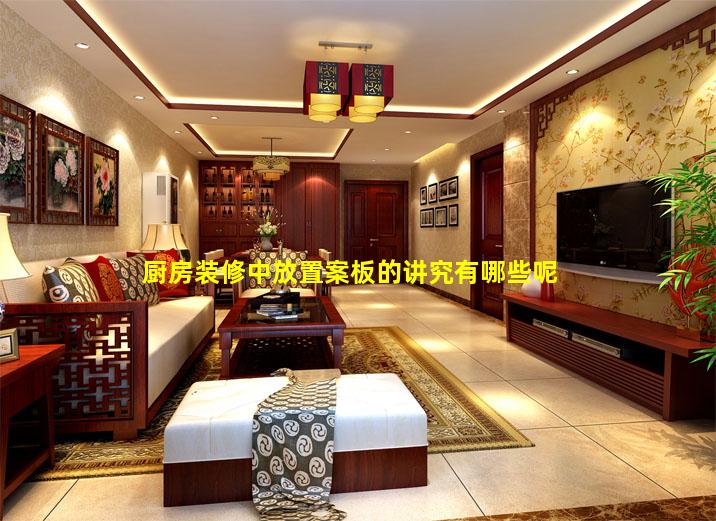





厨房装修中放置案板的讲究:
1. 位置选择:
靠近水槽和炉灶,方便取水和烹饪。
避免靠近窗户或通风口,以免受风吹影响。
确保有充足的照明,便于操作。
2. 尺寸和形状:
尺寸应根据厨房空间和使用习惯选择,一般长度在60120厘米之间。
形状可根据个人喜好和厨房布局选择,常见的有矩形、圆形和L形。
3. 材质选择:
实木案板:耐用、抗菌,但需要定期保养。
竹制案板:环保、耐用,但容易开裂。
塑料案板:轻便、易清洁,但耐用性较差。
复合材料案板:结合了不同材料的优点,耐用、易清洁。
4. 厚度:
案板厚度应在24厘米之间,太薄容易变形,太厚操作不方便。
5. 防滑处理:
案板底部应有防滑垫或橡胶脚,防止滑动。
6. 卫生清洁:
案板应定期清洁消毒,避免细菌滋生。
使用后及时清洗,并用消毒液擦拭。
定期用柠檬汁或白醋擦拭,去除异味和细菌。
7. 其他注意事项:
不同用途的案板应分开使用,避免交叉污染。
案板应放置在干燥通风的地方,防止发霉。
定期检查案板是否有裂缝或损坏,及时更换。
厨房装修中放置案板的讲究
视频链接: ()
文字说明:1. 位置选择
靠近水槽和炉灶,方便取水和烹饪。
避免靠近窗户或门,防止风吹动案板。
确保有充足的照明,便于操作。
2. 尺寸和形状
尺寸应根据厨房大小和使用习惯选择。
形状可根据个人喜好和厨房布局选择,如长方形、正方形或圆形。
3. 材质选择
实木案板:耐用、抗菌,但需要定期保养。
竹制案板:环保、耐用,但容易开裂。
塑料案板:轻便、易清洁,但耐用性较差。
玻璃案板:卫生、易清洁,但易碎。
4. 安装方式
嵌入式:将案板嵌入橱柜台面,美观且节省空间。
台面式:直接放置在橱柜台面上,方便移动。
壁挂式:将案板挂在墙上,节省台面空间。
5. 其他注意事项
防滑垫:在案板底部放置防滑垫,防止滑动。
定期清洁:用温水和洗洁精定期清洁案板,保持卫生。
避免切割生肉:生肉可能携带细菌,应使用单独的案板。
定期更换:当案板出现严重划痕或开裂时,应及时更换。

放置案板的讲究
1. 位置选择
靠近水槽和炉灶,方便取水和烹饪。
避免靠近窗户或通风口,以免受风吹影响。
考虑厨房动线,避免阻碍其他操作。
2. 尺寸选择
根据厨房大小和使用习惯选择合适尺寸的案板。
一般来说,长度在60120厘米,宽度在4060厘米。
3. 材质选择
木质案板:耐用、不易钝刀,但需要定期保养。
竹制案板:抗菌、耐用,但比木质案板更硬。
塑料案板:轻便、易清洁,但容易划伤。
玻璃案板:卫生、易清洁,但易碎。
4. 安装方式
嵌入式:将案板嵌入橱柜台面,美观且节省空间。
台面式:直接放置在橱柜台面上,方便移动。
壁挂式:悬挂在墙上,节省台面空间。
5. 其他注意事项
保持清洁:定期清洗案板,避免细菌滋生。
避免重压:不要在案板上放置过重的物品,以免损坏。
定期保养:木质案板需要定期涂抹油脂保养。
更换频率:当案板出现严重划痕或变形时,应及时更换。
图片示例:[图片1:嵌入式木质案板,靠近水槽和炉灶]
[图片2:台面式竹制案板,尺寸适中]
[图片3:壁挂式塑料案板,节省台面空间]
Considerations for Placing a Cutting Board in Kitchen Design
1. Accessibility: The cutting board should be easily accessible from the main work area, such as the sink or stovetop. Avoid placing it in a corner or behind other appliances.
2. Size and Shape: Choose a cutting board that is large enough to accommodate your typical food preparation tasks. Consider the shape of your kitchen and the available counter space.
3. Material: Cutting boards come in various materials, including wood, plastic, and glass. Wood is a traditional choice, but it requires regular maintenance to prevent bacteria growth. Plastic is durable and easy to clean, while glass is hygienic but can be fragile.
4. Height: If you plan to use the cutting board for extended periods, consider installing a pullout or builtin cutting board that can be raised to a comfortable height.
5. Storage: When not in use, the cutting board should be stored in a clean and dry place. Avoid leaving it on the counter or in the sink, as this can promote bacteria growth.
6. Hygiene: Regularly clean and disinfect the cutting board to prevent crosscontamination. Use hot soapy water or a bleach solution.
7. Multiple Cutting Boards: Consider having separate cutting boards for different types of food, such as meat, vegetables, and bread. This helps prevent crosscontamination and ensures food safety.
8. BuiltIn Cutting Boards: Some kitchen designs incorporate builtin cutting boards that are integrated into the countertop. These provide a seamless and hygienic surface for food preparation.
9. Lighting: Ensure that the cutting board area is welllit to provide optimal visibility during food preparation.
10. Ventilation: If possible, place the cutting board near a window or exhaust fan to minimize odors and fumes from food preparation.